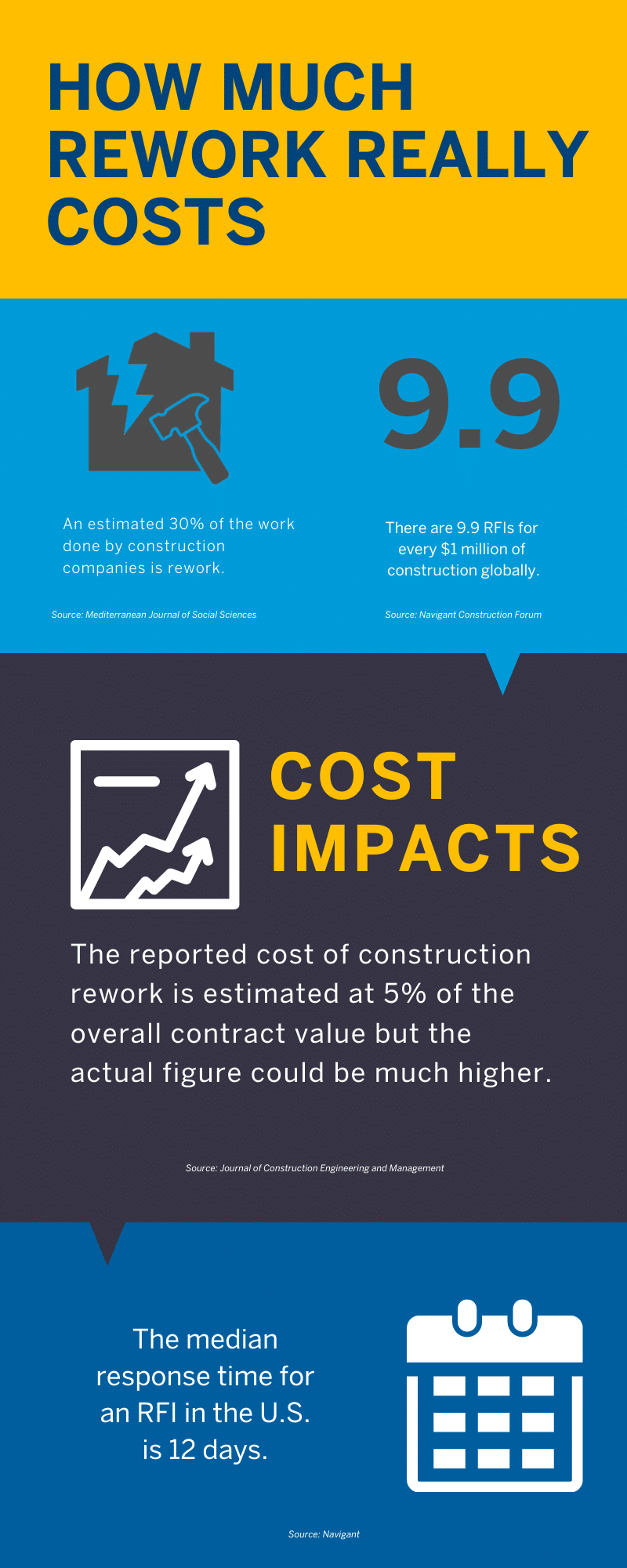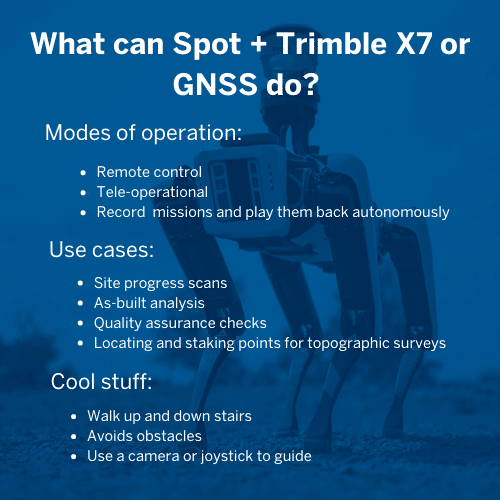Is the Robot Dog the Construction Industry’s New Best Friend?

The first time I met Boston Dynamics’ Spot the robot dog, I half-wished I had brought some dog biscuits to the jobsite with me. No really.
As Spot trotted past me, wrapping up a site progress scan of an almost-completed office building, I could feel a giant grin sweep up my face. Spot was more dog-like than I imagined — with an amazingly Labrador-like gait and a mechanical whir that sounded almost like panting. And then it sat back on its haunches, tilted its ‘head’ up at me just like my childhood dog used to do.
Autonomous Robot Dog Heads to Construction Sites
While it may still feel strange to think of robot dogs, let alone robot dogs on the jobsite, this technology has already arrived. If you were to visit the Great Hall renovation project at Denver International Airport (DIA), you might see Spot for yourself, outfitted with a Trimble X7 3D laser scanner and being used to safely and efficiently document project progress.
With the recent launch of an official alliance between construction technology firm Trimble and Spot’s creator, Boston Dynamics, the idea of having a fully autonomous robot on a construction site took a huge leap forward into reality. In the near future Spot will be fully integrated with Trimble technologies to:
- Perform precision topographic surveys over large geographic areas
- Capture daily stockpile analysis, quality assurance, and as-built analysis data
- Work in remote, dangerous, and unsafe site conditions
- Offer contractors a practical path for automating workflows
While there’s no denying Spot the robot dog has a “wow” factor, it’s much more than just a gee-whiz gadget. This highly versatile tool delivers a measurable return on investment for contractors like Hensel Phelps, who’s using Spot on the Denver airport project.
It couldn’t come at a better time, in my opinion. Construction firms must remain productive and competitive while grappling with social distancing guidelines, persistent labor shortages, and what could be an unprecedented demand for retrofitting, remodeling, and adaptive reuse projects.
Which is all to say, Spot could be your newest co-worker.
More Restrictions + Less Talent = Uncertainty
The quick onset of COVID-19 left many in the industry in a lurch. Many projects were temporarily stalled as both local jurisdictions and project stakeholders determined how to safely continue work. Even as we’ve settled into a new normal of sorts, it’s challenging to maintain social distancing and appropriate precautions when dozens or even hundreds of workers are needed to complete the project.
Even before the pandemic, the shortage of skilled labor was being felt by many in the construction industry. With job growth in construction projected to grow at 8 percent over the next 10 years, the need for skilled workers to staff construction projects, which in turn fuel economic growth, isn’t going away. But young people aren’t entering the construction field like they used to. At the same time, approximately 41 percent of the current construction workforce will retire by 2031.
The strain of a dwindling talent pool could be felt even more in the months to come. As the short and long-term effects of COVID-19 remain to be fully understood, some caution that the industry should brace itself for more challenges. For example, PwC warns that a dearth of available subcontractors specifically could create a ripple effect of labor shortages, grinding projects to a halt.
In the same article, PwC advised AEC companies to evaluate opportunities to automate repetitive tasks and reduce the number of workers on jobsites. Certainly these measures can help, but some may resist the recommendation to automate.
While the term “automation” can elicit resistance and fear, it’s more about driving productivity improvement in an industry that sorely needs it than replacing human workers. Automation can change job requirements by driving efficiency and safety, but it also requires the development of new skills and, as such, creates new jobs.
While uncertainties abound, the future isn’t all gloom and doom, though. The just-released Dodge 2021 Construction Outlook predicts the value of starts for residential buildings will increase 5% in 2021, while nonresidential buildings will gain 3% and non-building construction will improve 7%. The predicted growth will be spurred by the need for warehouse space among large e-commerce retailers, as well as the rising demand for data centers and renovation of existing buildings.
Commercial Remodels and Adaptive Reuse Are on the Rise
Commercial remodeling growth will be driven in part by tenant improvements. As organizations respond to the increase in remote work, they’re rethinking the traditional office space to meet new workforce needs. For example, KPMG reports that companies will embrace hybrid work models in the future, requiring office makeovers that result in more space for team meetings and less for individuals to work.
According to a Building Design+Construction article titled “Reconstruction Could Be COVID-19’s Silver Lining,” a new breed of health and wellness concerns is also prompting upgrades to existing systems. The adaptations are expected to include pandemic-driven improvements to technology infrastructure, upgrading of HVAC systems to improve air filtration, the addition of building features that let in more outdoor air, as well an increase in contactless features, like automatic door openers and sensor light controls.
Once-bustling commercial buildings may also need to be reinvisioned for new purposes, driving growth in adaptive reuse projects. Before the pandemic, it was expected that roughly 90 percent of construction activity would occur on existing buildings, including adaptive reuse projects. This prediction was prompted largely by trends indicating that the younger workforce would increasingly move back to urban centers to be closer to work, leaving suburban malls and office buildings to be razed or, more likely, reborn.
But now, the opposite may occur. News stories abound that people are fleeing to the suburbs and remote locales after enduring stay-at-home orders in dense urban areas. This migration could be accelerated by a continuation of remote work. The shift to working from home at least part of the time for those who can appears here to stay. And it will no doubt affect the landscapes of urban business centers. A Gartner survey of CFOs and finance leaders conducted just weeks into the pandemic found that 74% plan to move at least 5% of their previously on-site workforce to permanently remote positions post-COVID 19.
While it remains to be seen exactly what the future holds, the predictable needs for both tenant improvements and the repurposing of existing spaces present an opportunity for forward-thinking construction companies.
Using Spot the Robot Dog to Solve Commercial Retrofitting Challenges
Renovation and reuse projects also present unique challenges. There’s a saying that “what you don’t know won’t hurt you.” But that couldn’t be further from the truth when it comes to construction. Because many existing structures, especially older or historic buildings, lack original or current documentation, you could be hit with unforeseen expenses and schedule delays given an abundance of unknowns.
What’s hidden in the walls could be what you hoped for, or it could be some major surprises. And with those surprises, unexpected costs, as well as a greater likelihood of costly RFIs and rework. It could be argued that all construction bears a certain amount of risk. But commercial remodels and adaptive reuse projects can create additional threats to the schedule and budget.

Document a Construction Site Autonomously
Using Spot, outfitted with a 3D laser scanner, is particularly valuable on renovation projects. Spot can autonomously roam a site, using its scanner to capture as-built conditions or perform QA/QC by monitoring work in progress. The data Spot gathers with the Trimble X7 scanner can be used to produce a highly accurate BIM model, or identify potential clashes and discrepancies early on and before they snowball — a process called scan-to-BIM.
Spot can be guided by a worker located remotely or programmed to follow a route on its own. Spot could even work after everyone’s left for the day. You could have Spot walk every floor of your building, during the off hours, collecting a complete set of point clouds that are ready to go, available for the project manager when he or she arrives at the site the next morning. Either way, by relying on the robot-scanner duo, both productivity and safety are prioritized.
Equipped with Trimble 3D scanning technology, Spot the robot dog is helping contractors like Hensel Phelps to:
- Quickly and reliably collect large amounts of project data
- Use the scan data to produce as-built documentation either as point cloud data or 3D modelled objects
- Share the data across functional roles and teams, including BIM, project engineering, layout, and project management
“Using the technology to capture data is important for documentation, especially on a project where work was done by a previous general contractor,” said Drew Rebman, VDC Engineer, Hensel Phelps, in a recent Construction Dive article.
Adopt Spot the Robot Dog = Adopt Automation
The changes brought about the COVID-19 pandemic have highlighted the growing gap between those who have invested in technology and those still relying on inefficient manual processes. Furthermore, health and safety restrictions on the jobsite, as well as the push to conduct work remotely when possible aren’t expected to go away anytime soon.
The Boston Dynamics + Trimble alliance can help AEC companies automate dull, dirty, and dangerous tasks to maintain safety and drive productivity, even amid uncertain times. With the right technology, construction professionals can make the pivots needed to respond to sudden shifts and confidently navigate change, whether that involves a reconstruction project, a new build, or a recovering economy.
Link to Article: https://constructible.trimble.com/industry/is-the-robot-dog-the-construction-industrys-new-best-friend
Want us to keep you updated on the Robot Dog?
Just enter your information below and we’ll keep you updated on Robot Dog developments!
